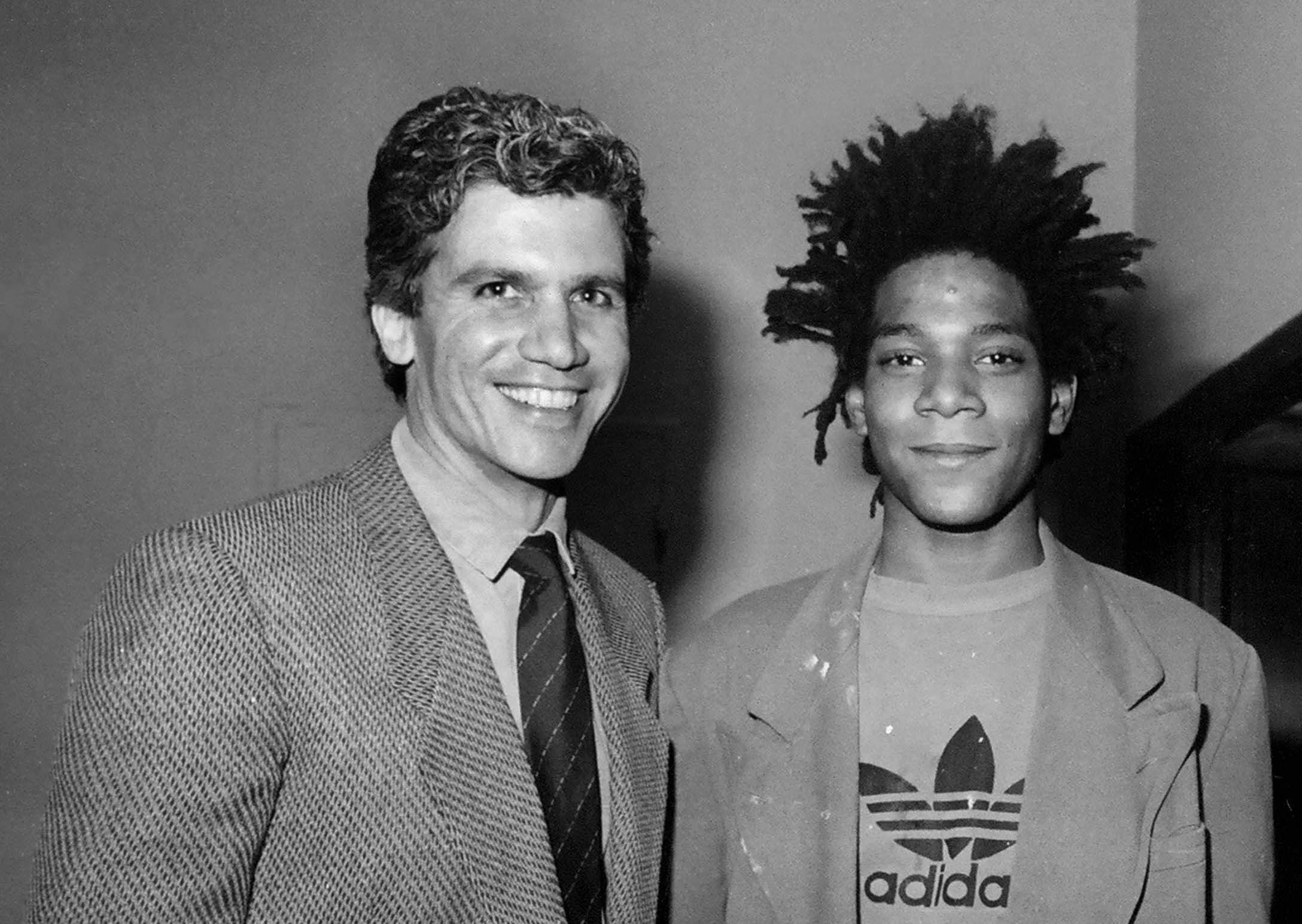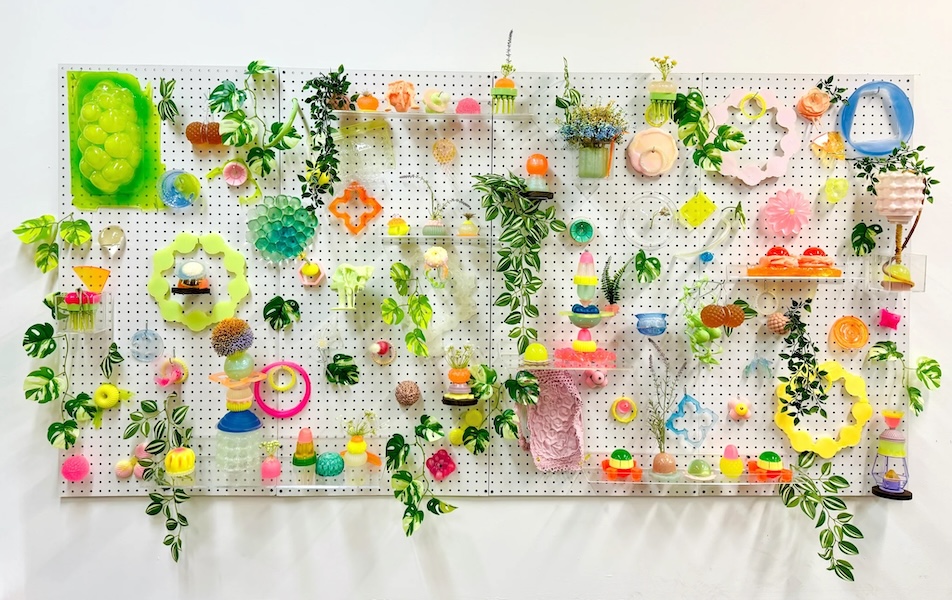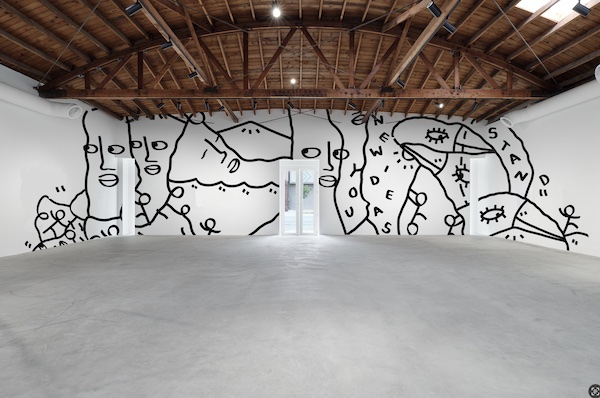With just 24 hours left until the debut of “Made on Market Street” at Gagosian Beverly Hills, featuring iconic works by Jean-Michel Basquiat, Larry Gagosian arrived in Los Angeles to oversee the final preparations. Although his last check-in with the LA team occurred a week prior with just paintings on the walls, Gagosian possessed intimate familiarity with all the artworks. Gagosian, who showed Basquiat’s work three times during the artist’s lifetime, worked closely with curator Fred Hoffman for the current exhibition.
Notably, the works in the show, on view now through June 1, were created by Basquiat during his residency in Los Angeles between 1982 and 1984. During part of this period, Basquiat lived and worked at 51 Market Street in Venice Beach, CA, situated within the residence of Gagosian himself, later moving a few doors down to establish his own space. Basquiat’s time in LA proved to be instrumental in his artistic development and recognition in wider America.
“I was just transfixed by these paintings and how powerful they were,” – Larry Gagosian
It all started in 1981 when Gagosian and Basquiat first met at Annina Nosei gallery in New York through their mutual friend Barbara Kruger. There was a group exhibition at Nosei’s gallery at that time. Larry walked into the third room and saw five or six paintings that left him in awe. As Gagosian recalls, “I was just transfixed by these paintings and how powerful they were.” Nosei’s office was behind this room of the show, and she came to greet him. Gagosian immediately offered to buy Basquiat’s works, most of which were already sold.
Nosei offered an introduction to the artist and a few days later, Larry was invited to Jean-Michel’s studio, which was underneath the gallery. The space was full of ground-breaking paintings, and Larry immediately suggested hosting Basquiat’s show in LA. The artist and Nosei welcomed the idea. And so it happened: Basquiat’s exhibition was presented at Gagosian in LA in April of 1982. It was an astounding success. Basquiat was heralded as a new, profound artistic voice, recognized both by the public and collectors alike. Gagosian invited the artist to stay in LA and use part of his house as Basquiat’s studio. The artist was excited to explore the West Coast.
But why did Gagosian choose LA to host Basquiat’s first show? To answer this question, one has to look at the context. An integral part of Basquiat’s art was urban culture. LA was, of course, known for the film industry and a center of American subcultures such as hip-hop, graffiti and street art, punk and hardcore music, skateboarding, and surfing cultures. LA was completely uncharted territory for Basquiat. It provided fertile ground for Basquiat’s own exploration of laid-back, West Coast urban life, contrasting with that of fast-paced New York.
Basquiat and the LA Music Scene
Basquiat’s contemporaries in LA included influential West Coast hip-hop artists such as Ice-T, N.W.A., Too Short, Egyptian Lover, and Dr. Dre. These musicians revolutionized the genre with their raw storytelling, socially conscious lyrics, and innovative production techniques, which resonated with Basquiat’s exploration of street culture in his artwork. As Larry put it, “Los Angeles has always been a great city for artists, and Jean-Michel seemed to find it a refreshing change from New York. While the immensity of his talent was immediately apparent, it was nonetheless a highlight of my own career to work with him, to introduce him to Los Angeles, and to witness the amazing impact that his art and legacy have made on our culture.”
Larry tasked Tamra Davis and Matt Dike to introduce Jean-Michel to people and places in LA. Davis was a film student at the Los Angeles City College and a gallery assistant, while Dike was a hip-hop artist. Davis remembers seeing Basquiat and Dike playing records. Dike, at that time, was about to launch his label, Delicious Vinyl. Basquiat spent a lot of time in Mike’s studio above Santa Monica Boulevard, meeting other hip-hop artists, such as Tone Loc.
Meanwhile, Davis was immersed in the early days of music video production, directing hits like Wild Thing for Tone Loc and Bust a Move for Young MC. As Davis recalled, “There was this New York/LA hip-hop scene, and Jean-Michel really loved being close to that. He identified with that; it felt really familiar for him.” During Basquiat’s visits to LA, he would spend time in the clubs with Davis and Dike, and diving deep into discussions about the latest developments in music and film industries. Then Basquiat would come back to the studio and spend all night painting.
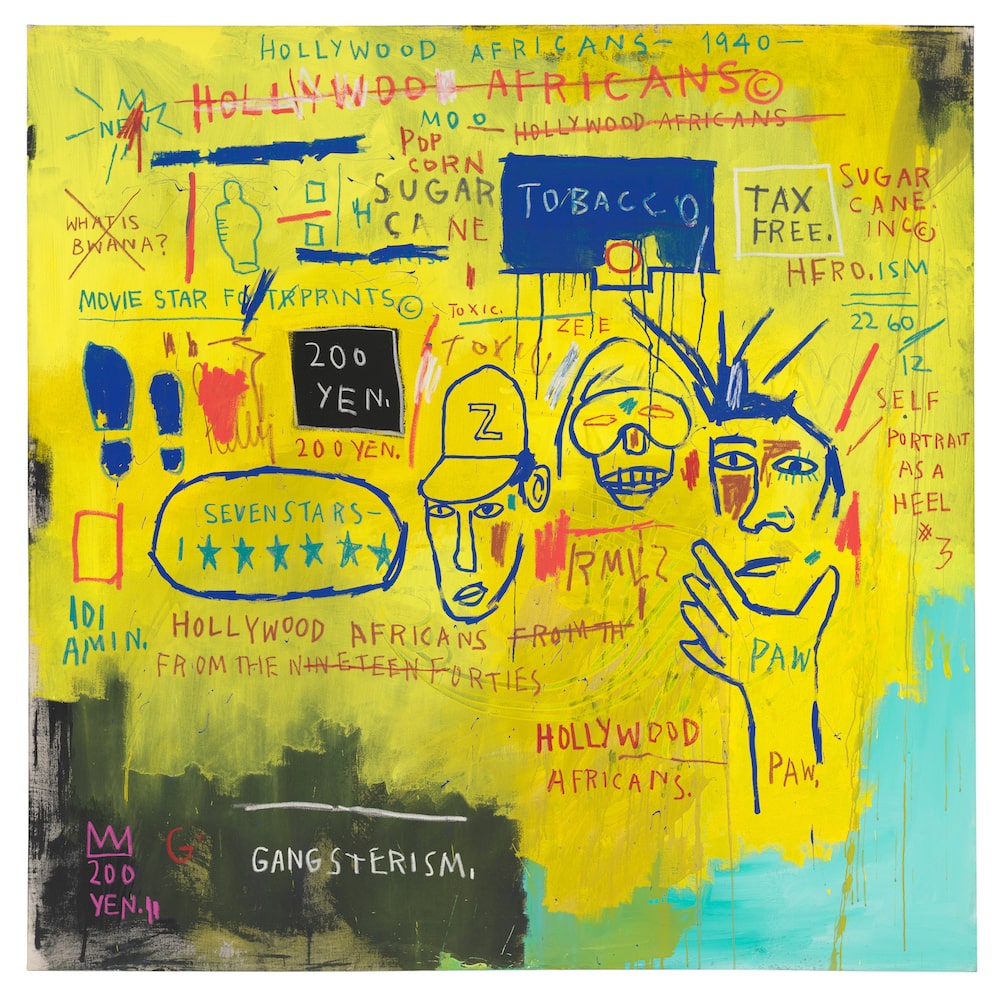
Jean-Michel Basquiat, “Hollywood Africans,” 1983, acrylic and oil stick on canvas, Whitney Museum of American Art, New York; gift of Douglas S. Cramer. © Gagosian Gallery.
In the 1980s, Los Angeles boasted an influential network of collectors, artists, and museums, and it was within this vibrant community that Gagosian showcased Basquiat’s work in April of 1982. This led to Basquiat’s recognition nationally, rather than solely New York. Larry saw that Basquiat’s art completed the missing puzzle in the art landscape and market of the 1980s. That first show in 1982 presented Basquiat as an artist who could be compared to young Jean Dubuffet’s work in their brutishness. The show attracted positive attention from collectors and newspapers, which laid a solid foundation for Basquiat’s presence on the West Coast.
A 1983 show at Gagosian in LA followed of new paintings exploring themes of “heroism, royalty, and the street.” According to Hoffman, the curator of Gagosian’s current show, Basquiat was prolific and quick to learn.
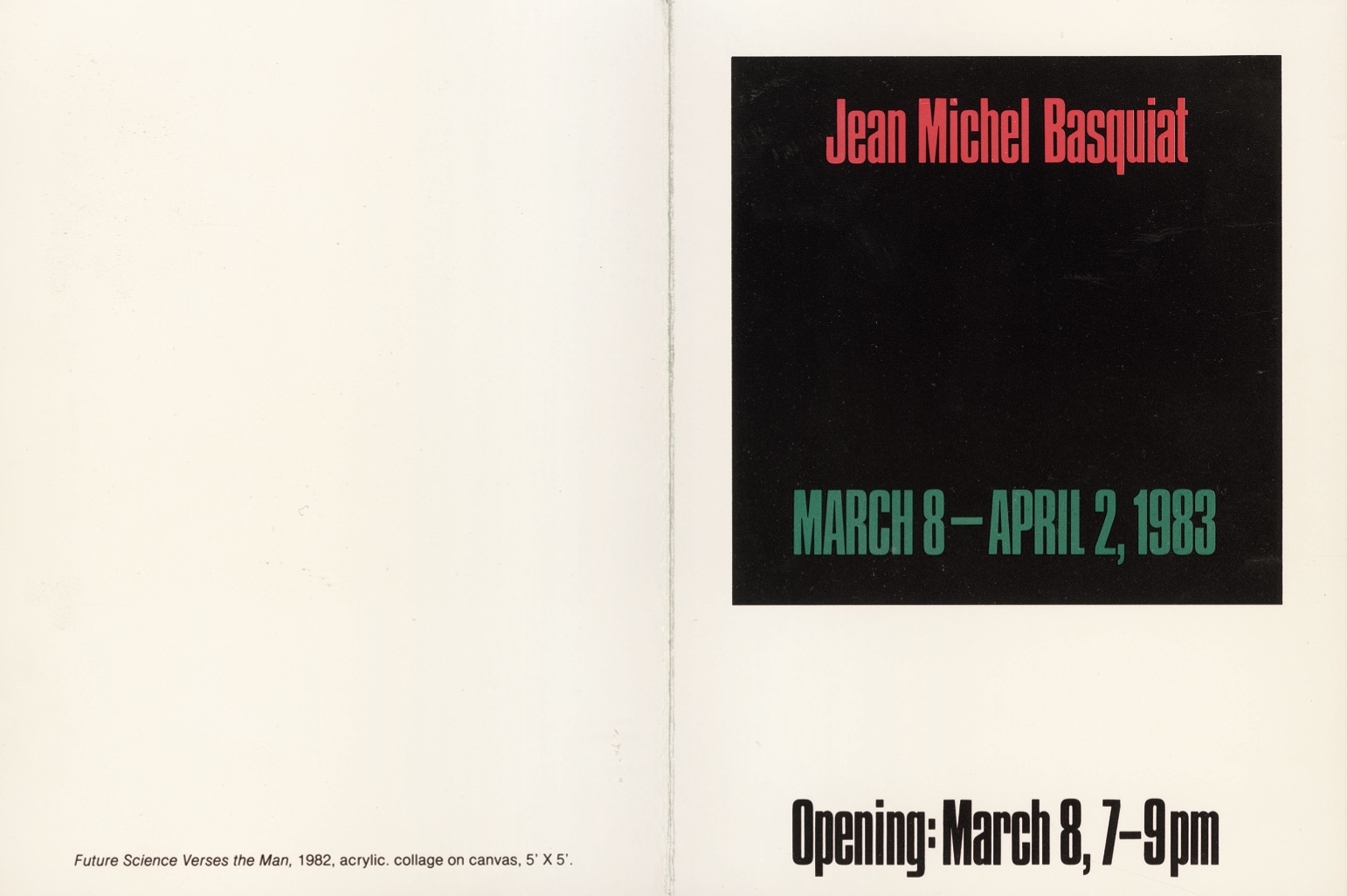
Invitation in the February 1983 issue of Art in America for “Jean-Michel Basquiat: New Paintings” at Larry Gagosian Gallery, Los Angeles, March 8–April 2, 1983. © Gagosian Gallery.
Basquiat Introduces Silk Screening into His Practice
Hoffman emerged as another significant figure in Basquiat’s professional life in LA, forming a fruitful relationship with the artist. He was Gagosian’s friend and met Basquiat at his studio at Larry’s House. Hoffman had a silkscreen shop, New City Editions. He encouraged Basquiat to push his work further, to integrate silkscreen paintings into his oeuvre, moving away from the labor-intensive method of collaging original drawings onto canvases.
Basquiat started making photocopies of original drawings and collaging those into his paintings. After Hoffman and Basquiat made Tuxedo, the artist embraced silk-screening as a more efficient technique. Their professional dynamic flourished as Hoffman understood where Basquiat wanted to go and helped him achieve the desired results quickly.
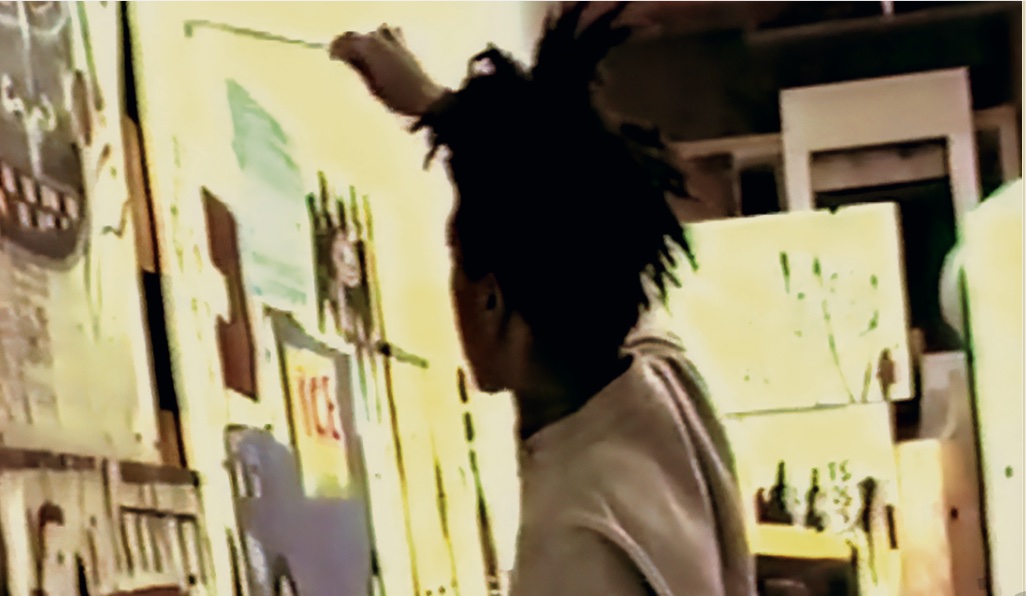
Jean-Michel Basquiat painting at New City Editions, Venice, California, 1983. Stills from Tamra Davis, “The Radiant Child” (2010). © Gagosian Gallery.
The creation of Tuxedo in LA in 1983 coincided with Basquiat’s work on the early rap record Beat Bop, released under his own label, Tartown Record Co. This long-playing 12-inch single was a collaborative effort with Fred Brathwaite, Toxic, A-One, Al Diaz, and Rammellzee. Basquiat’s cover for the record mirrored the reversal of black-and-white imagery seen in Tuxedo. This color reversal decision was not merely for aesthetic reasons, but an expression to challenge societal and cultural assumptions at the time, particularly regarding identity. It underscored his profound fascination with a newly discovered look, which he boldly introduced during this nascent stage of his career.
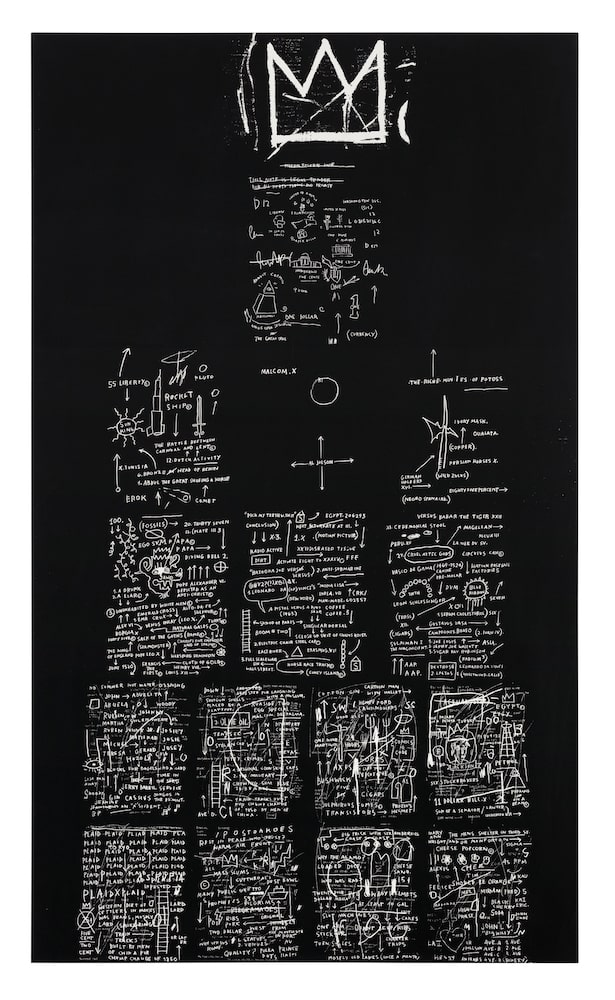
Jean-Michel Basquiat, “Tuxedo,” 1982, silkscreen on canvas, edition of 10, private collection, Los Angeles. Photo: Fredrik Nilsen Studio. © Estate of Jean-Michel Basquiat © Gagosian Gallery.
During his time at his second studio in LA, Basquiat focused extensively on refining his silkscreen painting technique while connecting with leading artists who employed this practice. A team of individuals would assist by holding various screens in place. This method allowed Basquiat to concurrently work on multiple paintings, resulting in approximately 40 distinct pieces. It became evident to Hoffman that Basquiat possessed a profound understanding of the methodologies employed by revered artists, particularly demonstrating a keen appreciation for the work of Robert Rauschenberg.
Hoffman, who shared a close friendship with Rauschenberg, facilitated an introduction between him and Basquiat. Reflecting on the encounter, Hoffman remarked, “After dinner one night, I introduced Jean-Michel to Bob at Gemini G.E.L. on Melrose. They spent an hour together in the print shop and had a complete connection. Jean-Michel returned multiple times afterward, once accompanied by me and once on his own.”
Basquiat Contends with the History of LA Artists
One evening, Gagosian, upon entering Basquiat’s studio, witnessed a striking scene: the artist, facing a series of pristine white canvases, boldly proclaimed his intent to encapsulate the history of contemporary painting in California. With Gagosian observing from a corner bed, Jean-Michel embarked on his ambitious endeavor. Each canvas became a space for experimentation, as he skillfully channeled the essence of prominent abstract California painters such as Chuck Arnoldi, known for his geometric abstractions; Richard Diebenkorn, celebrated for his “Ocean Park” series; Sam Francis, recognized for his vibrant, gestural works; and Ed Moses, known for his dynamic and energetic brushwork.
In a mesmerizing display of talent, Basquiat effortlessly evoked diverse pictorial sensibilities. As the night wore on, Gagosian found himself succumbing to sleep, only to awaken at dawn to a transformed studio. Basquiat had systematically obscured nearly all traces of California abstraction, opting instead to imbue each canvas with his distinct style. This remarkable metamorphosis showcased not only his artistic versatility but also his uncompromising commitment to forging his own path in the art world.
Basquiat’s success with exhibitions in LA at Gagosian, along with the exceptional works he created there, drew the attention of renowned collectors and led to invitations to participate in influential exhibitions. Notably, following one of Basquiat’s shows in LA, the esteemed New York gallerist Tony Shafrazi approached him for a piece for his upcoming group exhibition, “Champions.” This show marked the emergence of a new generation of artists whose work reflected the dynamic social and cultural currents of downtown New York in the 1980s. Prior to their inclusion in exhibitions like “Champions” at galleries such as Shafrazi and Fun, many of these artists had primarily worked on the streets, earning the label of “graffiti artists” for their outdoor tags and murals. “Champions” quickly became recognized as a pivotal moment, signaling the acceptance of this new generation within established gallery circles.
Initially, Basquiat submitted a silkscreen version of Tuxedo, only to be informed that the gallery desired a painting instead. Undeterred, Basquiat returned to his New York studio on Crosby Street and painted over sections of the imagery in the work. The altered piece was accepted by Shafrazi Gallery. With Tuxedo, Basquiat aimed to introduce a fresh aesthetic, distinct and inherently cool, which would assert his unique voice within downtown culture.
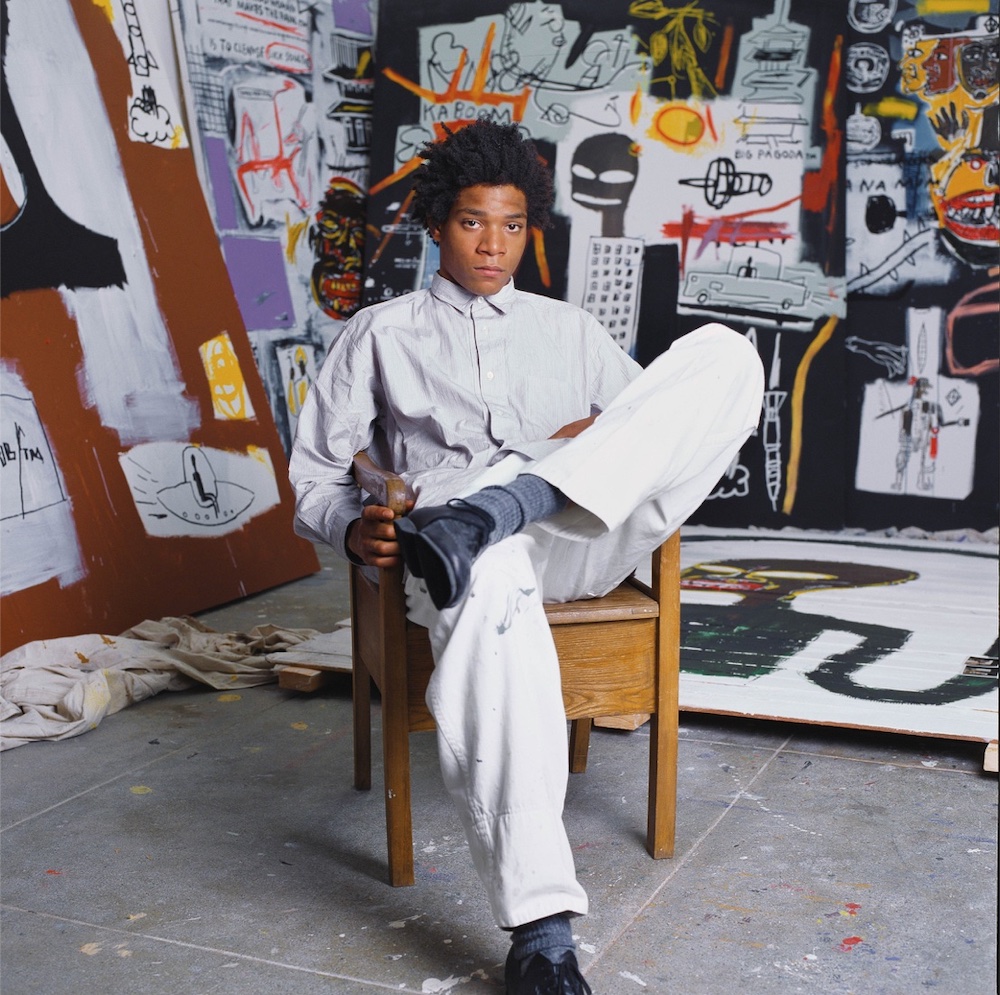
Jean-Michel Basquiat at his 21 Market Street studio, Venice, California, spring 1984. © Gagosian Gallery.
How Basquiat’s Time in LA Impacted the New York Scene
Despite his origins as a graffiti tagger, Basquiat had successfully transitioned into the world of New York art establishment. Tuxedo became his declaration of allegiance to street culture, showcasing his innovative approach to artistic expression. Just as every tagger has their signature mark, Basquiat’s key artistic choices in Tuxedo, particularly his reversal of whites and blacks, demonstrated his ability to forge an entirely original means of communication through art. Thus, Basquiat’s work in LA, which propelled him into the spotlight and secured invitations to significant art exhibitions, facilitated his advancement within the New York gallery scene.
Basquiat’s intermittent sojourns in LA, as recounted by Gagosian, reveal a strategic retreat from the pressures of New York, where his reception was often fraught with ambivalence. In this context, LA offered both solace and inspiration, enabling Basquiat to navigate his artistic journey with renewed vigor and creativity. The prolific output of at least a hundred canvases within 18 months by Basquiat attests to the fertile ground LA provided for his artistic exploration. It was within the vibrant cultural milieu of LA that Basquiat thrived, forever altering the landscape of contemporary art and leaving an enduring legacy in the art world.



